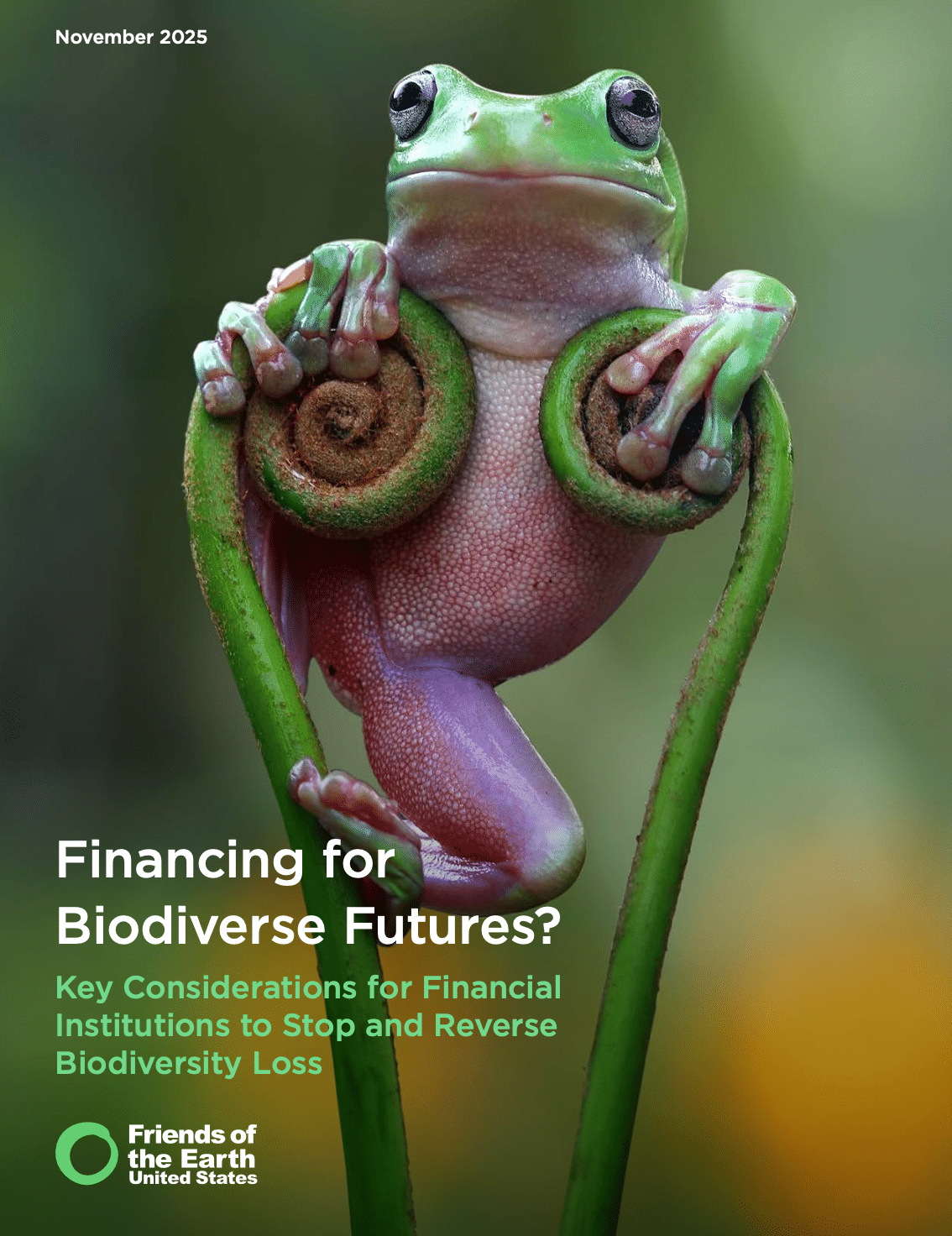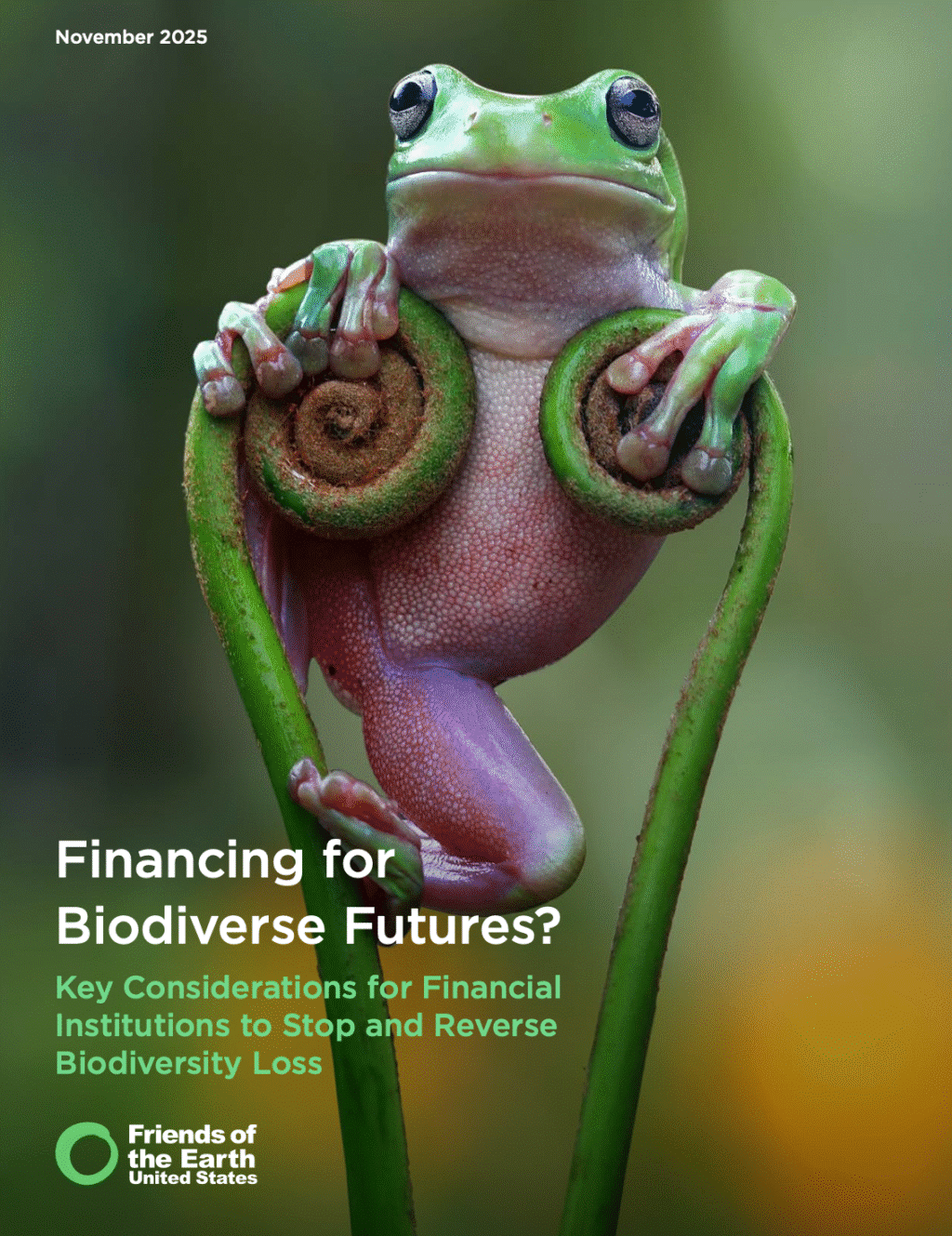Report: Financing for Biodiverse Futures?

Adopted during the fifteenth meeting of the Conference of the Parties (COP 15) of the Convention on Biological Diversity, the Global Biodiversity Framework (GBF) requires a “whole-of-society approach” in stopping and reversing biodiversity loss by 2030. The GBF is an international framework which mandates broad-based action to bring about a transformation in our society’s relationship with biodiversity by 2030. Per Target 14, it mandates that “all relevant public and private activities, fiscal and financial flows [are aligned] with the goals and targets of this framework.”
This report by Friends of the Earth US, originally published in October 2024, has been updated to reflect revised bank policies on biodiversity and an analysis of how these policies align with the Bank and Biodiversity Initiative’s eight proposed No Go areas. It explains how financiers must align with the GBF and develop a biodiversity plan to stop and reverse biodiversity loss, while also protecting Indigenous Peoples and affected communities. This report was originally published in October 2024 and updated in November 2025.
The report, “Financing for Biodiverse Futures? Key Considerations for Financial Institutions to Stop and Reverse Biodiversity Loss,” discusses how banks and financiers can develop an effective biodiversity plan. Stopping and reversing biodiversity loss should be the aim of a credible and comprehensive biodiversity plan, in line with the GBF, and should include the use of exclusionary areas, per the Banks and Biodiversity Initiative so that critical ecosystems and communities are protected from harmful financing.
Read the report here
Read the fact sheet here
Key Takeaways
- Banks and financiers are failing to protect biodiversity. According to an analysis of 13 major international financiers, financial institutions have yet to adequately protect critical ecosystems and areas where free, prior, and informed consent (FPIC) have not been obtained. In addition to sectoral prohibitions, financiers and banks must prohibit harmful financing that directly or indirectly harms at-risk, critical ecosystems, as they are essential for conserving biodiversity and regulating the climate. To do this, banks and financial institutions should prohibit harmful direct and indirect financing which may impact the eight proposed No Go areas of the Banks and Biodiversity Initiative.
- Financiers must measure and report their own biodiversity impacts, and their clients’ biodiversity impacts. This includes financiers measuring and reporting on the biodiversity impacts of its entire investment portfolio, and publicly reporting on all its impacts and progress, both positive and negative.
- Banks and financiers are well positioned to steer financing away from activities which harm biodiversity and the environment and should therefore commit to finding sustainable, new pathways and business models that prioritize stopping and reversing biodiversity loss.
Key Considerations for Developing an Effective Biodiversity Plan
The report explores key considerations in ensuring that biodiversity plans are fit for purpose in reducing biodiversity loss, and ultimately in restoring nature. Banks and financiers should incorporate the following key considerations that are reflected in their biodiversity plans:
- Establishing ambitious targets and metrics: Targets and metrics should go beyond merely conserving biodiversity or avoiding adverse impacts and instead aim to stop and reverse biodiversity loss.
- Prioritizing biodiversity in risk management and client engagement: These include adopting No Go areas and engaging clients to reduce and eliminate biodiversity risks. Prioritizing biodiversity in risk management involves avoiding false solutions such as biodiversity offsets.
- Establishing and requiring accurate measuring and reporting processes: This includes ensuring high quality data and not overly relying on client-provided data, which may be flawed. It also includes using a double materiality framework to assess biodiversity risk and impact to understand the short- and long-term impacts of their financing on not only biodiversity, but also the sustainability of their financial portfolios.
- Acknowledging the importance of governance and institutional accountability: Bank staff and board members’ performance should be measured against their management and contribution to the overall goal of stopping and reversing biodiversity loss. Internal bank environmental and biodiversity experts should be empowered to stop or intervene in cases of harmful bank supported activities, so that bank financing decisions take a precautionary approach and are based on the best available science.
- Harmonizing institutional goals: A biodiversity plan must complement key cross-cutting concerns, such as climate change, human rights, Indigenous Peoples’ rights, public health, and poverty —all recognized throughout the GBF.


Ways to Support Our Work

Read Latest News
Stay informed and inspired. Read our latest press releases to see how we’re making a difference for the planet.

See Our Impact
See the real wins your support made possible. Read about the campaign wins we’ve fought for and won together.

Donate Today
Help power change. It takes support from environmental champions like you to build a more healthy and just world.